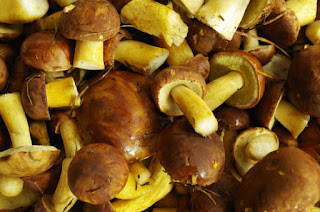 |
| Mushrooms contain unusually high amounts of antioxidants called glutathione and ergothioneine. Image credit: Jan Plywacz. |
The research paper highlighted some facts:
- Glutathione levels varied >20-fold in different mushroom varieties and were highly correlated with ergothioneine levels.
- Glutathione content of some mushroom species were higher than those previously found in other foods.
- Mushroom species high in glutathione and ergothioneine are an excellent dietary antioxidant source.
“What we found is that, without a doubt, mushrooms are highest dietary source of these two antioxidants taken together, and that some types are really packed with both of them.”
When the human body uses food to produce energy, it also causes oxidative stress because some free radicals are produced.
Free radicals are oxygen atoms with unpaired electrons that cause damage to cells, proteins and even DNA as these highly reactive atoms travel through the body seeking to pair up with other electrons.
Replenishing antioxidants in the body, then, may help protect against this oxidative stress.
“There’s a theory — the free radical theory of aging — that’s been around for a long time that says when we oxidize our food to produce energy there’s a number of free radicals that are produced that are side products of that action and many of these are quite toxic,” Professor Beelman said.
“The body has mechanisms to control most of them, including ergothioneine and glutathione, but eventually enough accrue to cause damage, which has been associated with many of the diseases of aging, like cancer, coronary heart disease and Alzheimer’s.”
The amounts of ergothioneine and glutathione in mushrooms vary by species with the porcini species, a wild variety, containing the highest amount of the two compounds among the 13 species tested, the study found.
“We found that the porcini has the highest, by far, of any we tested. This species is really popular in Italy where searching for it has become a national pastime,” Professor Beelman said.
The more common mushroom types, like the white button, had less of the antioxidants, but had higher amounts than most other foods.
The amount of ergothioneine and glutathione also appear to be correlated in mushrooms. Mushrooms that are high in glutathione are also high in ergothioneine, for example.
“Cooking mushrooms does not seem to significantly affect the compounds. Ergothioneine are very heat stable,” Professor Beelman said.
Michael D. Kalaras et al. 2017. Mushrooms: A rich source of the antioxidants ergothioneine and glutathione. Food Chemistry 233: 429-433; doi: 10.1016/j.foodchem.2017.04.109
Source: Sci-news






No comments:
Post a Comment